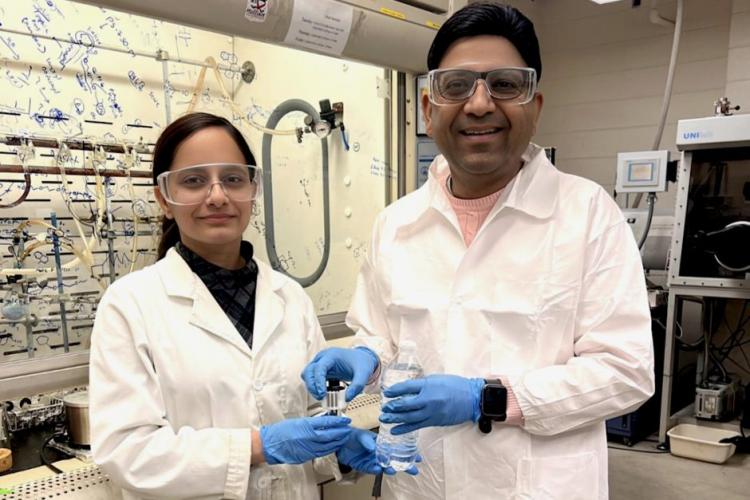
Sachin Handa and Karanjeet Kaur show an example of their new chemical tool in Handa's lab at the University of Missouri. Photo courtesy Sachin Handa
Contact: Eric Stann, StannE@missouri.edu
University of Missouri researchers and collaborators have developed an innovative, eco-friendly chemical tool that harnesses the power of engineered “soapy” water and electricity to create reactions in a whole new way. This breakthrough electrochemistry method could reduce the cost of making medicines and support clean energy technology, including efforts to remove per- and polyfluoroalkyls (PFAS), also known as “forever-chemicals,” from water.
Traditional electrochemistry relies on toxic solvents and electrolytes. In a search for non-toxic alternatives, Associate Professor Sachin Handa and graduate student Karanjeet Kaur, alongside Novartis Pharmaceuticals, developed environmentally friendly substances called micelles — tiny molecular structures made from natural amino acids and coconut oil.
These ball-shaped structures have two sides: one that mixes with water and the other that repels it. Their unique design allowed researchers to make electrochemical reactions more efficient by combining the traditional roles of solvents, electrolytes and reaction boosters into one simple tool. Bonus: The reactions are highly efficient and selective.
Handa and Kaur discovered the technique while trying to find a way to use micellar water and electricity as a green source to drive chemical reactions, a process known as micellar electrochemistry.
“Notably, these micelles drive desired reactions forward, but they don’t react with anything and remain stable, making them unique from ionic micelles,” Handa, whose appointment is in Mizzou’s College of Arts and Science, said. “By making the process more effective, this advancement could help improve the development of medicines — including inhibitors targeting proteins, such as the NS5A of the Hepatitis C virus — and may be used to treat hyperproliferative, inflammatory and immunoregulatory diseases.”